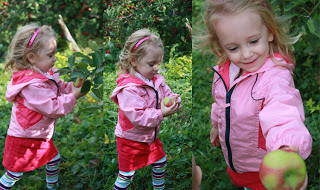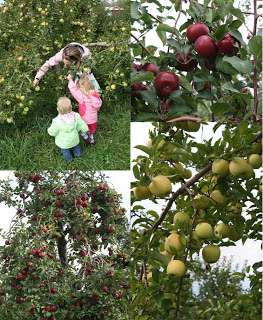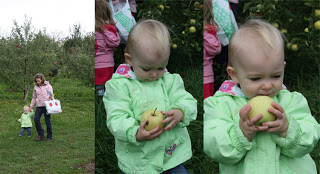For the last month it feels like we’ve been living in a black hole. From time to time we’ve popped our head out to blog here and there, but mostly it’s been nose to the grindstone on gluten-free book projects. It’s also been prime harvest season here in the Hudson Valley, and a few Saturdays ago we took an afternoon off, packed up the girls, and headed to a local orchard to do some good old fashioned apple pickin’.
We drove across the Hudson River to Wilklow Orchards, in Ulster County. Wilklow is a regular fixture out our semi-weekly local farmer’s market (walking distance from our house), and so when it came time to decide which orchard to visit, Wilklow was at the top of our list. You pick your own apples by the half-bushel bag, which Wilklow sells for $18. Each bag holds 20-25 pounds of apples. If you do the quick math, that equals lots of local, fresh apples for less than $1 per pound. How can you beat that?
Since then, we’ve been enjoying apples every which way. I’ve been eating roughly two a day straight up. We’ve had sliced apples with peanut butter. We’ve made two apple pies (one of which we photographed for the revised second edition of Artisanal Gluten-Free Cooking, due out May next year). But I just might be the most excited about the hard apple cider fermenting away right now. After we had finished picking apples, we picked up three gallons of fresh-pressed apple cider from the farm’s tiny country store. One gallon we drank. But two gallons we “brewed” to make a hard cider that we’ll hopefully be drinking on Thanksgiving.
As homebrewing goes, making hard apple cider is about as easy as it gets. Strictly speaking, all you need is apple cider or apple juice and yeast. That’s it. Sure, you can add more ingredients (such as brown sugar, to help boost the final alcohol content of the cider). And yes, you can complicate the process by racking and aging the cider to both clarify the brew and mature the flavors. But that’s all optional.
The trick is to make sure you’re using fresh-pressed cider or juice that does NOT contain preservatives, such as sodium benzoate or potassium sorbate. They’ll kill your yeast, and you’ll end up with a wasted batch of cider. With in mind, you’re good to go!
For this recipe, I went with a champagne yeast. Normally used in winemaking, it works very well for cider (so I’ve heard…this is my first batch). And by stroke of luck, our local homebrew shop gave Kelli the yeast for free! Having spent $10 for 2 gallons of fresh cider, having gotten the yeast for free, and already having the brew equipment, we’re looking at a cost of about 50 cents per bottle of cider, or $3 per six pack, roughly 1/3 what we pay for a 6 pack of Woodchuck.
Hard Apple Cider
Yield (accounting for loss when racking and taking hydrometer measurements) = ~20 bottles
Ingredients
2 gallons fresh-pressed apple cider (preservative-free)
1/2 cup packed light brown sugar
1 packet (5g) champagne yeast (I used Lalvin EC-1118)
Steps
1. Sanitize all of your brewing equipment.
2. Pour one gallon of cider into your carboy.
3. Heat the second gallon of cider in a pot on your stove to about 140 deg F. Dissolve in the brown sugar.
4. Pour the heated cider into the carboy. The cider should equalize to about 90 deg F. Allow to cool to below 80 deg F.
5. Pitch the yeast and shake/swirl to aerate. Place an airlock on the carboy and let the fermenting begin! (The fermentation is complete after you get steady hydrometer measurements for three consecutive days.)
This recipe is: gluten-free, egg-free, dairy-free, fish-free, shellfish-free, nut-free, tree-nut-free, soy-free.
This recipe is easily made refined-sugar-free by substituting honey, molasses or another natural sweetener for the brown sugar.
Notes:
1. If you’re using truly untreated fresh-pressed cider, you should heat ALL of your cider to at least 140 deg F, but NOT to boiling point (which will “set” the pectins and cause hazy cider), to kill off any wild yeast or bacteria. Allow the full batch to cool to below 80 deg F before pitching your yeast. If using UV-treated or pasteurized cider, follow the directions as in the recipe.
2. Homebrewed cider naturally finishes pretty dry. Most commercial ciders back-add sugars to sweeten the cider and balance the tartness of the apples. There’s no need to do that with a homebrewed cider. Many people enjoy it dry.
3. If you want carbonated cider, you can do one of two things: force carbonate, or bottle condition, as in beer brewing. (I do the latter.)
4. If you want to back-sweeten your cider AND carbonate it, things get more complicated. Email me for details.
Otherwise, enjoy!
– Pete





Hi Pete,
I am so incredibly jealous,really green with envy, that you can walk to a farmer’s market. I have to drive 25 miles for a very small one.
I lived for several of my younger adult years, and then again later for 14 months in Madison,WI, whose Dane County Farmer’s Market is phenomenal. I tried to capture a little bit of it last spring:
http://accordingtothemom.blogspot.com/2011/05/dane-county-farmers-market.html
And I admit, I’m a also a bit jealous that you can enjoy an apple orchard. We live so far north, near that little bit of MN that is zone 2on the hardiness maps,that I have to drive 90 miles to find an orchard, and that is a baby one, only about four years old. There are varieties of apples that are nominally hardy here;many people plant trees in their yards. We have throughout the years planted, maybe six or seven trees, but so far the longest lifespan we’ve had without winter kill is 4 years.
I can’t wait to see your newly revised cookbook. I’m sure it will tempt me sorely with it’s beautiful photographs and artful presentation. I loved the presentation and composition of the cup cakebook.
Hi Mary… That Dane County market looks great! Thanks for sharing the link to your post about it.
Yeah, being back in “apple country” is one thing we’ve very much enjoyed about moving to the Hudson Valley. Colorado’s apple orchards were virtually non-existent!
Has winter gripped northern MN yet? Our garden is definitely done for the year…
Cheers, Pete
I haven’t been online as much lately, so I didn’t see your question, but yes, as of this week, winter is back. We had a very long fall, which the farmers (and the rest of us) appreciated. But my Wednesday morning walk was in 3inches of fresh snow at 12F, and yesterday’s overnight low was just a few tenths of a degree above zero. It’s time to hunker down, eat comfort food,and do lots of visiting. After living here for almost ten years, I’ve come to understand and appreciate culture up here. It’s definitely a survival thing.